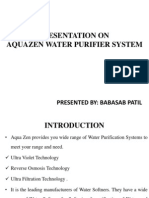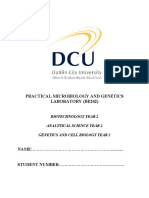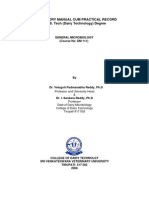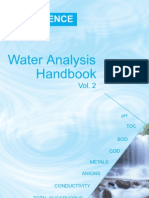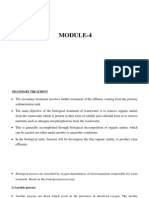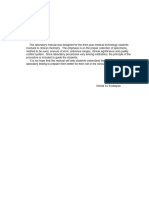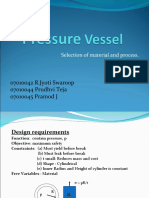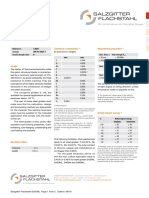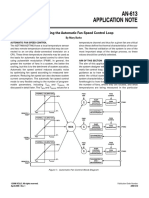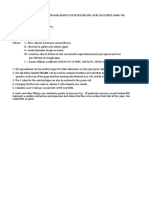0 ratings0% found this document useful (0 votes)
295 viewsManual For Water Testing in Lab.
Manual For Water Testing in Lab.
Uploaded by
pkgoyal1983This document provides an operational manual for water quality testing laboratories. It outlines important safety precautions when working with hazardous chemicals, proper sampling techniques to ensure representative samples, guidelines for accurately recording and reporting analytical data, and procedures for various water quality analyses. The overarching goals are to produce reliable water quality results and ensure the safety of laboratory staff.
Copyright:
© All Rights Reserved
Available Formats
Download as PDF, TXT or read online from Scribd
Manual For Water Testing in Lab.
Manual For Water Testing in Lab.
Uploaded by
pkgoyal19830 ratings0% found this document useful (0 votes)
295 views36 pagesThis document provides an operational manual for water quality testing laboratories. It outlines important safety precautions when working with hazardous chemicals, proper sampling techniques to ensure representative samples, guidelines for accurately recording and reporting analytical data, and procedures for various water quality analyses. The overarching goals are to produce reliable water quality results and ensure the safety of laboratory staff.
Original Description:
drinking water test
Original Title
Manual for Water Testing in Lab.
Copyright
© © All Rights Reserved
Available Formats
PDF, TXT or read online from Scribd
Share this document
Did you find this document useful?
Is this content inappropriate?
This document provides an operational manual for water quality testing laboratories. It outlines important safety precautions when working with hazardous chemicals, proper sampling techniques to ensure representative samples, guidelines for accurately recording and reporting analytical data, and procedures for various water quality analyses. The overarching goals are to produce reliable water quality results and ensure the safety of laboratory staff.
Copyright:
© All Rights Reserved
Available Formats
Download as PDF, TXT or read online from Scribd
Download as pdf or txt
0 ratings0% found this document useful (0 votes)
295 views36 pagesManual For Water Testing in Lab.
Manual For Water Testing in Lab.
Uploaded by
pkgoyal1983This document provides an operational manual for water quality testing laboratories. It outlines important safety precautions when working with hazardous chemicals, proper sampling techniques to ensure representative samples, guidelines for accurately recording and reporting analytical data, and procedures for various water quality analyses. The overarching goals are to produce reliable water quality results and ensure the safety of laboratory staff.
Copyright:
© All Rights Reserved
Available Formats
Download as PDF, TXT or read online from Scribd
Download as pdf or txt
You are on page 1of 36
NATIONAL DRINKING WATER MISSION
(Department of Rural Development, Government of India)
OPERATIONAL MAN UAL
for
WATER QUALITY TESTING LABORATORIES
MAY 1990
CONTENTS
Sl. No. I tem Page No.
1. SAFETY PRECAUTIONS IN LABORATORIES 1
2. DOs AND DONTs IN LABORATORIES 4
3. SAMPLING 5
4. RECEORDING AND REPORTIONG DATA 7
5. PROCEDURE FOR ANALYSIS OF VARIOUS
PARAMETERS
9
6. PROFORMA FOR MONTHLY REPORTING OF
FUNCTIONS OF DISTRICT LABORATORY
27
7. LIST OF DOCUMENTS TO BE MAINTAINED 29
I
SAFETY PRECAUTIONS IN LABORATORY
1.1 Precautions with Hazardous Chemicals:
- All containers must be clearly labeled and read before opening. If
dispensing into another contained, put label alongwith warning.
- Minimal stocks not exceeding 500 ml of corrosive or flammable
solvents only may be kept in work room. Keep in safe place in
plastic covered metal cabinet.
- Glacial acetic acid must be regarded as a flammable solvent.
- Ether and low boiling point flammable liquids must not be kept in
fridge.
- Large container of corrosive or flammable liquids should never be
put on high shelves or where they can be knocked down or fall.
Never put liquids that react violently together closely.
- Never carry bottles by neck alone. Open bottles with care.
- When diluting concentrated sulphuric acid or other strong acids, it
should be added to water in heat resistant vessel.
1.2 Spillage of Hazardous Chemicals
- If amount is small, dilute with water or detergent. It amount is
large protective apron, rubber gloves and boots are worn and
treatment carried out according to wall chart showing how to
manage chemical spillage.
- Hydrochloric acid and sulphuric acid can be neutralized with
anhydrous sodium carbonate then shovelled into a plastic bucket
which is subsequently diluted by water and run to waste. Ammonia
solution, ethanol, methanol and formalin are best treated by
diluting with water, collection and running to waste. Windows
must be opened. Phenols must be diluted with atleast 20 times the
volume of tap water before running to waste.
1.3 First Aid
The First Chart should be mounted on a nearby wall. The first aid box
must be accessible with Laboratory Staff. An emergency eye wash bottle
with a bottle of sterilised water should be readily available. A Universal
poison antidote is useful. Activated aluminium oxide or a tin of
evaporated milk should be readily available. A tin opener and some water
proof dressing material should also be readily available.
1.4 Avoidance of Hazards of Equipment
- Trained staff should operate the equipments.
- Operating instructions should be followed.
- Check the autoclave filled with water to correct level before
loading.
- Water or moisture on electrical fittings is dangerous.
- If fire breaks out, near electrical equipment should immediately be
switched off and disconnected.
- Take care to avoid live wires.
- When not in use switch off and withdraw plug from socket.
- Avoid contact with wires as may think dead but if wrongly
connected may be live.
- Avoid use of multi-adaptors, if have to use it, must be fitted with
fuses.
1.5 Fire extinguishers
- Water extinguishers are suitable for fires involving ordinary
combustible materials e.g. wood, paper, textile, upholstery. Never
use on electrical fires or liquids that will catch fire.
- Dry powder extinguishers or sand are suitable for liquids on fire,
electrical fires and burning metals. CO
2
extinguishers suitable for all
types of fire particularly for minimising damage to laboratory
equipment.
II
DOS AND DONT IN LABORATORY
- NEVER EAT, SMOKE OR DRINK IN LABORATORY
- NEVER MOUTH PIPETTE
- WASH HANDS BEFORE STARTIANG WORK, PREFERABLY WEAR A
CLEAN LABORATORY COAT.
- REGULARLY CLEAN WORKING AREA WITH DISINFECTANT.
- USE ONLY MEDIA AND EQUIPMENT KNOWN TO BE STERILE.
- NEVER TOUCH PART OF PIPETTE TUBES ETC., WHICH WILL COME
IN CONTACT WITH STERILE SAMPLE.
- OPEN TUBES OR PETRI DISHES FOR MINIMUM TIME.
- ALL CULTURES TUBES, PETRI DISHES SHOULD BE AUTOCLAVED
BEFORE DISPOSAL OR RELEASE FOR WASHING UP.
- ALL USED PIPETTES MUST BE DISCARDED BY IMMERSING IN
DISINFECTANT (e.g. > SAVLON) J ARS FILLED TO ALLOW ALMOST
COMPLETE IMMERSION. CHANGE DISINFECTANTLY DAILY.
- AVOID SPLASHING INFECTIOUS MATERIAL CREATING AEROSOLS
OR DISPERSING INFECTIOUS MATERIAL INTO THE ENVRONMENT.
III
SAMPLING
3.1 It is well recognized that the result of any test procedure can be no
better than the sample on which it is performed. The objective of
sampling is to collect a portion of material small enough in volume
which can be transported easily and handed in the laboratory while
still accurately representing the material being collected.
3.2 The sampling programme defines the portion of the whole to which
rest results apply. The variations of the whole material with
respect to time, area, depth, and occasionally, rate of flow must be
taken into consideration to ensure representative nature of the
sample. It is not possible to specify detailed procedure for
collection of all types of samples. However, a general guidelines as
suggested below may be followed:
3.3 General Guidelines and Precautions
- Collect a sample that conforms to the requirements of the sampling
programme and handle it carefully so that it does not deteriorate or get
contaminated during its transport to the laboratory. Before filling the
container rinse it two or three times with the water being collected.
Representative samples of some sources can be obtained only be making
composites of samples collected over a period of time or at a number of
different sampling points.
- While collecting a sample from the distribution system, flush lines
adequately, taking into consideration the diameter and length of the pipe
to be flushed and the velocity of flow.
- Collect samples from tube-wells only after sufficient pumping to
ensure that the sample represents the ground water source.
- When samples are to be collected from a river or stream, analytical
results may vary with depth, flow, distance from the shore and from one
shore to the other. If equipments are available for collection of
integrated sample from top to be bottom in the middle of the stream
and composite the sample according to the flow, Grab or catch sample
should be collected in the middle of the stream and at mid depth.
- Since lakes and reservoirs are generally undergo considerable
variation due to normal natural causes, choose location, depth and
frequency of sampling depending on local conditions and the objective of
the study.
- Make detailed record of every sample collected and identify each
contained by attaching a tag or label. Record information like date, time
and exact location, weather condition, stream-flow etc.
3.4 Quality of Sample to be Collected
Normally a 2-litre sample would be sufficient for most physical and
chemical tests. Never use the sample for chemical, bacteriological and
microscopic examinations, because collection and test procedures for the
latter tests are different.
3.5 Time Interval between Collection and Analysis.
The interval between collection and analysis of the sample should be
shortest possible.
IV
RECORDING AND REPORTING OF DATA
4.1 The District Laboratory shall keep records of submitted samples and
completed analysis in a manner that provides for the data retrievability,
the sample preservation and the persons responsible for the sampling and
analysis. All laboratory data sheets shall be dated and signed by the
analysts and the Head of the Laboratory or his designee.
4.2 Electrical conductivity, pH, temperature, and turbidity should be recorded
in units specified for the respective tests and the results of other chemical
examinations shall be expressed in terms of substances or ions actually
determined and reported as milligram per litre, which may be considered
for all practical purposes as equivalent to parts per million (ppm).
4.3 A commonly used and functional method of recording laboratory data is a
note book specifically printed for this purpose. The pages are serially
numbered in pairs with a carbon between the pages to provide matching
serial numbered copy of the data. These books are permanently bound
but the duplicate page is performated for easy removal. The duplicate
page may then be filed in a system wherefrom it may be readily retrieved.
The pages of the note book are generally lined in a grid pattern with
provision for such information as project identification, data, reference to
the analytical procedure, the observations, sample calculations, as mg/1
and signature of the analyst.
4.4 Analytical Quality Control
The basic objective of a water analysis laboratory is to produce accurate
data describing the physical-chemical characteristics of water samples
under study. Quality assurance is the total programme for assuring the
reliability of analytical data. Items discussed in this document can all be
considered as contributing to the overall programme of quality assurance.
Another essential component of a quality assurance is analytical quality
control which refers to the routine application of procedures for controlling
the measurement process.
4.4 Internal quality control or statistical quality control is the most important
component of any laboratory quality control programme. Experience
indicates that 10-20% of the resources of a laboratory should be devoted
to such work. Suitable approaches to internal quality control should be
followed.
4.5 External quality control is best applied after incorporating internal quality
control practices in the laboratory, and consists in the periodic analysis of
reference samples. These reference samples may not be different from
the control samples which the laboratory has been preparing for its own
use, with the exception that the amount of each substance present is
unknown to the analysts.
V
PROCEDURE FOR ANALYSIS
OF VARIOUS PARAMETERS
5.1 Colour
The platinum cobalt method of measuring colour is the standard method,
the unit of colour being that produced by 1 mg platinum/ litre in the form
of chloroplatinate ion. It is applicable to measure the colour of potable
water and of water in which colour is due to naturally occurring materials.
Even a slight turbidity effects the colour. Remove turbidity by
centrifugation for 1 hours. As colour varies with pH, specify the pH at
which colour is measures.
Field Method
As the platinum-cobalt standard method is not convenient for field use,
compare water colour with that of glass discs held at the end of metallic
tubes containing glass comparator tubes filled with sample and colourless
distilled water. Match sample colour with the colour of the tube of clear
water plus the caliberated coloured glass when viewed by looking towards
a white surface.
Collect representative samples in clean glassware and make the colour
determination within a reasonable period.
Appratus
a) Nessler tubes, 50 ml, tall form
b) pH meter
Preparation of standards
Dissolve 1.246 g potassium chloroplatinate, K
2
PtCl
6
(equivalent to 500 mg
metallic Pt) and 1.00 g. crystallized CoCl
2 2
O (equivalent to about 250 mg
metallic Co) in distilled water with 100 ml conc. HCl and dilute to 1000 ml
distilled water. This stock standard has a colour of 500 units.
Prepare standards having colours of 5, 10, 15, 20,.70 by diluting the
stock colour standard with distilled water to 50 ml in Nessler tubes.
Procedure
Observe sample colour by filling a matched Nessler tube, to the ml mark
with sample and comparing it with standards. Looking vertically
downwards through tubes towards a while surface placed at such an
angle that light is reflected upward through the columns of liquid. If
turbidity is present, report as apparent colour. If value exceeds 70, dilute
sample according so that value is within 70.
Measure pH of the sample
Report nearest to 1 if value is 1-50, nearest to 5 for 51-100, to 10 for
101-250 & to 20 for 251-500.
5.2 Hydrogen ion Concentration (pH)
Purpose
It is one of the most important and useful tests in the control of water.
Many chemical and biochemical reactions like place at a certain pH value
or within narrow pH range. Control of pH is particularly important in the
chemical cogaulation of water, softening etc.
Theory
The pH of a solution denotes the intensity of the acidity or alkalinity of a
solution and is defined by the relationship:
PH + - log
10
C
H
Where C
H
= the concentration of Hydrogen ions in gm. Ion per letre.
The pH scale runs from 0.0 to 14 with 7.0 being neutral. Many surface
water have pH between 6.0 to 8.5.
The pH can be measured by the indicator method and by the
electerometric method using a pH meter. The equipments needed include
colour standards covering the pH range desired, indicator solutions
corresponding to the colour standards, a comparator designed to
facilitate the matching of the colour and special test tubes to hold the test
sample. The electrometric method requires a pH metere which is a
sensitive instrument.
Procedure
In this method the pH metere is first calibrated against a solution of
known pH and the test well is then filled with the sample. The pH is read
directly either from the scale on the instrument of digital display as the
case may be. This method is most accurate and almost free from
interferences. It is imperative to follow strictly the manufacturers
direction.
5.3 Turbidity
Suspension of particles in water interfering with passage of light is called
turbidity. Turbid waters are undesirable from aesthetic point of view in
drinking water supplies and may also affect products in industries. Turbid
water also possess a number of problems in water treatment plants.
Turbidity is measured to evaluate the performance of water treatment
plants.
Principle
The method is based on a comparison of the intensity of light scattered by
a sample and a standard reference under the same conditions. Higher the
intensity of scattered light higher the turbidity.
Interference
Colour is the main source of interference the measurement of turbidity.
Appratus
Turbidimeter or Klett Summerson.
Reagents
1. Solution I: Dissolve 1.0 g hydrazine sulfats and dilute to 100 ml.
2. Solution II: Dissolve 10.g hexamethylene-tetramine and dilute to
100 ml.
3. Mix 5 ml of I with 5 ml of II. Allow to stand for 24 hrs. and dilute
to 1000 ml. This will have turbidity of 400 units.
4. Standard turbidity suspension: Dilute 100 ml of solution III as
prepared above to 100 ml too have turbidity of 40 units.
Procedure
1. Prepare calibration curves in the rage 0-400 unit by carrying out
appropriate dilutions of solutions III and IV above and taking readings on
turbidimeter.
2. Take sample or a suitably diluted aliquot and determine its turbidity
either by visual comparison with the diluted standards or by reading on
turbidimeter.
3. Read turbidity from the standard curves and apply correction due
to dilution, if necessary.
4. Report the readings in turbidity unit.
5.4 Conductivity
Conductivity is a numerical expression of the ability of an aqueous solution
to carry an electric current. This ability depends upon the presence of
ions, their total concentration, mobility, valence and relative
concentrations and on the temperature of measurement.
Apparatus
1. A good conductivity meter with cell.
2. Thermometer
Reagents
1. Conductivity water with conductivity less than 1 mho/ cm.
2. Standard potassium chloride solution (0.01 N). Dissolve 745.6 mg
anhydrons KC1 in conductivity water and dilute to 1000 ml at 25
o
C. This
has a conductivity of 1413 mhos/ cm at 25
o
C.
Procedure
Rinse conductivity cell with atleast three portions of 0.01 N KC1 solution.
Adjust temperature of a fourth portion to 25.0 0.1
o
C. Measure
conductivity which should be 1413 mhos/ cm. If not adjust the meter to
read this value using the cell constant knob. Note the cell constant.
Rinse cell with one or more portions of sample. Adjust temperature of a
final portion to 25.0 0.1
o
C. Read the conductivity value and note the
temperature.
5.5 Hardness
Hardness in water causes scale formation in boilers. It is also
objectionable from view point of water use for laundry and domestic
purposes since it consumes a large quantity of soap. Generally, salts of
Ca and Mg contribute hardness to natural waters. Hardness may be
classified either as (1) carbonate and non-carbonate hardness or (2)
calcium and magnesium hardness or (3) temporary and permanent
hardness.
Principle
In alkaline condition EDTA reacts with Ca and Mg to form a soluble
chelated complex. Ca and Mg ions develop wine red colour with
eriochrome black T under alkaline condition. When EDTA is added as a
titrant the Ca and Mg divalent ions get complexed resulting in sharp
change from wine read to blue which indicates end point of the fitration.
The pH for this titration has to be maintained at 10.0 0.1. At a higher
pH, i.e., about 12.0 Mg ion precipitates and only Ca ion remains in
solution. At this pH Murex indicator form a pink colour with Ca
++
When
Edta is added Ca
++
gets complexed resulting in a change from pink to
purple which indicates end point of the reaction.
Interference
Metal ions do interfere but lkexan be overcome by addition of inhibitors.
Reagents
1. Buffer solution: Dissolve 16.9 g NH
4
Cl in 143 NH
4
OH. Add 1.25 g
EDTA Mg salt to obtain sharp change in indicator and dilute to 250 ml.
This has to be titrated with standard calcium solution to avoid interference
produced by addition of EDAT to the buffer.
2. Inhibitor: Dissolve 4.5 g hydroxyl amine hydrochloride in 100 ml
95% ethyl alcohol.
3. Erichrome black T Indicator: Mix 0.5 dye with 100g NaCl to
prepare dry powder.
4. Murex indicator: Dry powder.
5. Sodium hydroxide 2N: dissolve 80 g NaOh and dilute to 1000 ml.
6. Standard EDTA solution 0.01 M: Dissolve 3.723 g EDTA sodium salt
and dilute to 1000 ml. Standardize against standard Ca solution, 1 ml
= 1 mg CaCO
3.
7. Standard calcium solution: Weigh accurately 1.0 g AR grade CaCO
3
and transfer to 250 ml conical flask. Place a funnel in the neck of a
flask and add 1+1 HCL till CaCO
3
dissolves completely. Add 200 ml
distilled water and boil for 20-3- min. to expel CO
2
Cool and methyl
red indicator. Ad NH
4
OH 3N dropwise till intermediate orange colour
develops. Dilute to 1000 ml to obtain 1 ml 1 mg CaCO
3.
Procedure
A. Total Hardness
1. Take 25 or 50 ml well mixed sample in porcelain dish or conical
flask.
2. Add 1-2 ml buffer solution followed by 1 ml inhibitor.
3. Add a pinch of Erichrome black T and titrate with standard EDTA
(0.01 M) till wine red colour changes to blue. Note down to vol. Of
EDTA required. (A)
4. Run a reagent blank if buffer is not checked properly. Note the
vol. Of EDTA or Ca required by blank (b).
5. Calculate vol. of EDTA required by sampe, C= (A-B) from vol. of
EDTA required in steps 3 & 4.
6. Calculate as follows:
Total hardness mg/l as CaCO
3
= C x D
3
x 1000
ml of sample
where
C = Vol. of EDTA required by sample.
D = mg CaCO
3
per 1.0 ml EDTA 0.01 M used as titrant.
B. Calcium Hardness
1. Take 25 or 30 ml sample in a porcelain dish.
2. Add 1 ml NaOh to raise pH to 12.0 and a pinch of indicator.
3. Titrate with EDTA till pink colour changes to purple. Note the vol.
of EDTA used (A).
4. Calculate as follows:
Calcium hardness mg/l as CaCO
3
= A
1
x D
3
x 1000
ml of Sample
where
C = Vol. of EDTA required by sample.
D = mg CaCO
3
per 1.0 ml EDTA 0.01 M used as titrant.
Magnesium hardness = Total hardness Ca hardness.
5.6 Chloride
Purpose
The chloride estimation has two different purposes.
1. If the test is done regularly on a water supply and there is a
sudden increase, it may indicate pollution due to ingress of sewerage or
other chloride rich wastes.
2. Many ground waters have chloride content high enough to be of
objectionable taste. By using the chloride test, the well with the lowest
amount of chloride can be identified. If several well are being pumped, it
can be planned in such a way that the lowest chloride content is obtained.
Principle
The Mohr method for the determination of chloride in water is based upon
the fact that in solution containing chloride and chromate, silver reacts
with all the chloride and precipitates before the reaction with chromate
begins. The appearance of the brick-red colour of the silver chromate
precipitate is the end-point of the titration.
Reagents
Potassium chromate indicator, 5% solution, standard silver nitrate solution
0.0282 N (1 ml = 1 mg of chloride).
Procedure
1. Take 100 ml of sample and adjust the pH between 7.0 and 8.0
2. Take 50 ml of well mixed sample adjusted to pH 7.0 8.0 and add
1 ml of potassium chromate indicator.
3. Titrate with standard silver nitrate solution till the colour changes
from yellow to brick-red.
4. Titrate 50 ml of distilled water in the same way after adding 1 ml of
potassium chromate indicator to establish reagent blank.
Calculation
Chloride, mg/l as cl = (A B) x 1000
Ml of Sample
Where
A = ml of AgNO
3
required for sample
B = ml of AgNO
3
required for blank.
5.7 Iron
Presence of iron causes nuisance in public water supplied. It occurs both
in soluble and insoluble forms. When the iron is present in considerable
amounts in water it imparts colour and also develops turbidity when
exposed to air due to its conversion to ferric state. Hence, the water
becomes unacceptable for drinking purposes from an aesthetic point of
view. Further, it interferes with laundering operation, imparts
objectionable stains, causes difficulties in the distribution systems and
imparts taste even at low concentrations (0.3 mg/l).
Principle
The ferric form of iron is reduced to ferrous form by boiling with HC1 and
hydroxylamine hydrochloride. Later phenanthroline is added at pH
between 3.2 and 3.3 to form soluble chelated complex of orange red
colour with iron. The colour obeys Beers Law and the intensity of colour
is independent of pH between 3 and 9.
Interference
Stron oxidizing agents such as CN, NO
2
, polyphosphates, Cr, Zn in Conc.
10 times the Fe conc; Co and Cu if 5 mg/l, Ni if 2 mg/l colour and
organic matter constitutes sources of interference in the development of
colours.
Boiling with HCl and addition of hydroxylamine remove interferences
due to CN, NO
2
, PO
4
and other oxidizaing reagents. The metal ions get
complexed with phenanthroline.
Apparatus
1. Colorimeter with an operating range of 400-700 mu.
2. Nesslers tubes.
Reagents
1. HCl cone.
2. Hydroloxylamine soloution: Dissolve 10g NH
2
OH HCl and dilute to
100 ml.
3. Ammonium acetate buffer: Dissolve 250 g NH
4
C
2
H
3
O
2
in 50 ml
distilled water. Add 700 ml conc. Glacial acetic acid. Final
volume will be slightly more than 1000 ml.
4. Phenanthrolone solution: Dissolve 100 mg/l: 10 phenanthroline
monobydrate in 100 ml distilled water warm slightly or add 2
drops cone. HCl if necessary. 1 ml of this colution can chelate
100 mg iron.
5. Stock iron solution: Add 20 ml conc. H
2
SO
4
to 50 ml distilled water
and dissolve 1.404 g Fe (NH
4
)
2
(SO
4
)
2
6H
2
O. Add drop-wise 1 N KM
nO
4
till faint pink colour persists. Dilute to 1000 ml. 1 ml = 200
mg Fe.
6. Standard iron solution: Dilute 50 ml stock Fe solution to 1000 ml.
Prepare this solution freshly. 1 ml = 10 mg Fe.
Procedure
1. Take suitable aliquot (about 50 ml having 2 mg/l Fe) of well mixed
sample in 125 ml conical flask.
2. Add 2 ml conc. HCl followed by 1 ml hydroxyl amine solution.
3. Add2-3 glass beads and boil for 20-25 min. to ensure dissolution of
Fe.
4. Cool to room temp. and transfer to Nesslers tubes.
5. Add 10 ml amm. acetate buffer and 2 ml phenanthroline solution.
6. Dilute to 100 ml and mix well.
7. Prepare blank by substituting the sample by water.
8. For soluble iron determination, take known vol. of filtered
sample, acidify by adding 2 ml. Conc. HCl per 100 ml of sample
and treat from step 5 onwards for colour development.
9. Prepare calibration curve taking standard iron solution in the
same way in the range 1000-4000 mg/l with 1 cm light path.
10. Measure the developed colour after 10 mn. at 510 mu.
11. Calculate the concon. of total or soluble Fe present in the sample
from caliberation curve and express as mg/l.
5.8. Fluoride
Fluoride ions have dual significance in water supplied. Excess
concentration of F causes dental fluorosis (disfigurement of the teeth).
At the same time, a concentration less than 0.8 mg/l results in `dental
caries. Hence, it is essential to maintain the F conc. Between 0.8 to
1.0 mg/l in drinking water.
Principle
Under acid condition fluorides (HF) react with zirconium SPADNS solution
and the lake (colour of SPADNS reagent) gets bleached due to formation
of ZRF
6
. Since bleaching is a function of fluoride ions, it is directly
proportional to the conc. of F. It obeys Beers Law in a reverse manner.
Interference
Alkalinity 5000 mg/l, aluminium 0.1 mg/l, chloride 7000 mg/l. Fe 10
mg/l, PO
4
16 mg/l, SO4 200 mg/l and hexametaphosphate 1.0 mg/l
interfere in the bleaching action. Residual Cl2 interferes in bleaching
action. In presence of interfering radicals distillation of sample is
recommended.
Apparatus
1. Colorimeter for use at 570 M/U.
2. Nesslers tubes cap. 100 ml.
Reagents
1. SPADNS solution: Dissolve 958 mg SPADNS and dilute to 500 ml.
2. Zirconyl acid ragent: Disslove 133 mg ZrOCL
2
. 8H
2
O in 25 ml
water. Add 350 ml conc. HCl and dilute to 500 ml.
3. Mix equal volume of 1 and 2 to produce a single reagent. Protect
from direct light.
4. Reference solution: Add 10 ml SPADNS solution to 100 ml distilled
water. Dilute 7 ml conc. HCl to 10 ml and add to diluted SPANDS
solution.
5. Sodium arsenite solution: Dissolve 15.0 g NaASo
2
and dilute to
1000 ml.
6. Stock F solution: Dissolve 221.0 mg anhydrous NaF and dilute to
1000 ml. 1 ml = 100 mg F.
7. Standard F: Dilute stock solution 10 times to obtain 1 ml = 10
mgF.
Procedure
1. Prepare standard curve in the range 0.0 to 1.40 mg/l by diluting
appropriate volume of standard F solution to 50 ml in Nesslers
tubes.
2. Add 10.0 ml mixed reagent prepared as in 3 above to all the
samples, mix well and read optical density to bleached colour at
570 mu using reference solution for setting zero absorbance.
3. Plot cone. vs % transmission.
4. If sample contains residual chlorine remove it by adding NaAsO
2
solution 1 drop (o.05 ml = o.1 mg Cl) NaAsO
2
conc. should not
exceed 1300 mg/l to avoid error due to NaAsO
2.
5. Take suitable aliquots of sample and dilute to 50 ml in Nesslers
tubes.
6. Add mix reagent 10 ml; mix well and read % transmission.
7. Calculate the mg F present in the sample using standard curve.
8. Calculate F mg/l as follows:
= mg F in aliquot x 1000
ml of Sample
5.9 Residual Chlorine
A. Iodometric method
This method is suitable for measuring total chlorine concentration greater
than 1.0 mg/l.
Reagents
Glacil acetic acid, potassium iodide crystals, 0.01 N sodium thiosulphate
solution, starch indicator.
Procedure
1. Add about 1 gm. of potassium iodide to each of the bottle followed
by 10 ml of acetic acid; stopper the bottle and mix.
2. Titrate released iodine with standard thiosulphate solution using
starch as indicator. Note the volume required for each bottle.
Calculation
Residual Chlorine mg/l = ml of Thiosulphate x N x 35.5 x 1000
ml of Sample
where
N = Normality of the thiosulphate solution.
B. Orthotolidine Method Principle
Orthotolidine is an aromatic organic compound which reacts with both
free and combined in acid solution to form a yellow coloured compound,
the intensity of the colour being directly proportional to the concentration
of chlorine in the sample. The orthotolidine reacts instantaneously with
free chlorine but its reaction with combined chlorine is rather slow. The
method is more sensitive to lower concentrations of chlorine and is
affected by temperature and contact time. The maximum and minimum
concentration of residual chlorine that can be measured by this method is
10 mg/l and 0.01 mg/l respectively.
If it is desired to identify both free and combined residual chlorine and
also to find out if any additional colour has been produced by interfering
substances present in the sample, the Orthotolidine arsanite method
should be employed.
Apparatus
1. Chlorine comparator.
Reagents
Orthotolidine Reagent and Sodium arsenite Reagent.
Procedure
1. Take 0.5 ml orthotolidine reagent in the 10 ml cell supplied with
the equipment and add sample upto the mark and mix thoroughly.
2. Compare the colour developed immediately (within 10 seconds).
The colour developed is that for free residual chlorine.
3. Compare the coklour again exactly after 5 minutes. The colour
developed includes both for free combined chlorine.
4. Compare both the colours with that of the standards supplied with
the equipment and express in results in mg/l chlorine.
5. The combined residual chlorine Total residual free residual.
5.10 Bacteriological
The following is the test method done as a routine for bacteriological
analysis of water.
Presumptive coliform count (a quantitative test for all coliform
bacilli/100ml)
Description of Presumptive Coliform Count method
The coliform count takes notices of only those organisms which are
gram-negative, nonsporing aerobic or facultative anaerobic, red shaped
micro organisms capable of fermenting lactose with the production of
acid and gas within 48 hours at 37
o
C.
Procedure
An estimation of the number of coliform bacilli in water supply is usually
made by adding varying quantities of the water (from 50 ml to 0.1 ml) to
MacConkeys broth or in a chemically defined medium contained in the
bottle and test tubes with Durhams tubes to show the formation of gas.
Depending on the quality of the water, the samples may be inoculated
as follows:
With Good & Medium
Quality (filtered or
chlorinated tubewell)
Poor Quality All Qualities
Media(MacConkeys
broth)
50mlx1 10mlx5 5mlx5 10mlx5 5mlx5 5mlx5 10mlx5
Strength of Media D.S. D.S. D.S. D.S. S.S. S.S. D.S.
Water 50ml 10mlx5 1mlx5 10mlx5 1mlx5 0.1mlx5 10mlx5
Incubation 37
o
C (48 hours) 37
o
C (48 hours) 37
o
C (48 hours)
(D.S. = Double strength, S.S. = Single strength)
Very bad water may required use of 1 in 100 or in 1000 or higher
dilutions. For a relatively poor quality of water 5 tubes method may be
used. In this method five 1 ml quantities each to 5 ml single strength
MacConkeys broth are inoculated for 48 hours at 37
o
C and results are
recorded from probable tables.
Results
Those that show acid and sufficient gas to fill the concavity at the tope of
the Durhan tube are considered to be presumptive positive as a result of
growth of coliform bacilli.
Reporting Results
The results are reported in terms of the presumptive number of
coliform bacilli per 100 ml (i.e. MPN Most Probable Number/100 ml) by
computation from tables complied by McCrady.
MONTHLY REPORTING OF FUNCTIONS OF DISTRICT LAB
State :_____________ Month :____________
__________________________________________________________________________
1. Name of District :
Mini Mission District :
Other District:
2. Name of the Incharge of Laboratory:
3. No. of Samples received:
4. No. of Samples analysed:
Physical & Chemical :
Biological :
5. No. of Samples analysed:
(Physical & Chemicals)
For all parameters :
For specific prameters :
6. Results of the samples for specific problem:
No. of samples indicating Excess Iron :
No. of samples indicating Excess Fluoride :
No. of samples indicating Brackishness:
No. of samples for any other problem:
No. of samples for monitoring of existing
DF/Fe/Deslination Plants:
7. Reporting of the results sent to:
CE on date:
District Medical Officer on date:
Executive Engineer date:
Regional Centre on date:
Reporting Channel
Incharge of laboratory will send one copy of above report to:
i. Executive Engineer, PHED
ii. District Health Officer
iii. Chief Engineer, PHED
and send 2 copies to their Regional Centre. The Regional Centre will give their
own comments and forward it to DRD, New Delhi for compiling the data on
National basis.
VII
LIST OF DOCUMENTS
The following documents are to be maintained in each district laboratory :
a) Report on collection and codification of samples
b) Proforma for test report
c) Report on number of samples tested
d) Statement of recurring expenditure for operation of laboratory
e) Stock register of consumables
f) Stock register of equipment/furniture
g) Attendance register of the staff
NATIONAL DRINKING WATER MISSION
EXPORT ON COLLECTION AND CODIFICATION OF
SAMPLES
STATE: DISTRICT LAB
AT:
Sl.
No.
Name
of
Source
Date of
Collection
Date of
Receipt
in Lab.
Quantity of
Sample(Ltrs)
Mode of
Transport
Parameters
Required
Code No.
Allocated
Remark
1. 2. 3. 4. 5. 6. 7. 8. 9.
NATIONAL DRINKING MISSION
PROFORMA FOR WATER ANALYSIS REPORTS (TEST REPORTS)
STATE:______________ DISTRICT LAB
AT:_________
1. DATE OF EXAMINATION :
2. SAMPLE CODE :
3. PURPOSE OF TEST REPORT :
(PARAMETERS REQUIRED)
Sl.No. PARAMETERS VALUE
1. 2. 3.
i)
ii)
iii)
iv)
v)
vi)
vii)
viii)
ix)
x)
xi)
xii)
PH
TEMPERATURE (
O
C)
COLOUR
TURBIDITY
CONDUCTIVITY
TDS
TOTAL HARDNESS
ALKALINITY, as CaCO
3
IRON
FLOURIDE
RESIDUAL CHLORINE
PRESENCE OF COLIFORM
ANY OTHER
REMARKS:
SIGNATURE
INCHARGE LABORATORY
NATIONAL DRINKING MISSION
DAILY REPORT ON NUMBER OF SAMPLES TESTED
(DATE:______________)
STATE:______________ DISTRICT LABORATORY
AT:______________
SL.NO. SAMPLE
CODE
DATE OF
COLLECTION
OF SAMPLE
TYPE OF
ANALYSIS
CARRIED
OUT
DATE
OF
ISSUE
OF
TEST
REPORT
TYPE OF
PROBLEM
IDENTIFIED
REMARKS
1. 2. 3. 4. 5. 6. 7.
NATIONAL DRINKING WATER MISSION
MONTHLY STATEMENT OF RECURRING EXPENDITURE FOR OPERATION
OF LABORATORY AND TESTING COST
FOR THE MONTH OF:___________
STATE:_________ DISTRICT
LABORATORY AT:___________
Sl.No. ITEM AMOUNT
(Rs.)
REMARKS
1. 2. 3. 4.
1.
2.
3.
4.
5.
6.
7.
8.
9.
SALARY, WAGES ETC.
TRAVEL, TOUR ETC.
PURCAHSE OF CONSUMABLES
i) CHEMICALS
ii) GLASSWARE
iii) OTHERS
MAINTENANCE EXPENSES
i) EQUIPMENT
ii) BUILDING
iii) TRANSPORT ETC.
COST OF UTILITIES
(POWER, WATER, FUEL ETC.)
MISCELLANEOUS
SUB-TOTAL OF ITEMS 1-6
NUMBER OF SAMPLE TESTED
COST OF ANALYSIS OF ONE SAMPLE ITEM
7/8
NATIONAL DRINKING WATER MISSION
STOCK REGISTER FOR EQUIPMENT FURNITURE
STATE:___________ DISTRICT LABORATORY
AT:____________
(Separate sheet for each equipment/furniture)
1. Name of the Item :
2. Brief specification :
3. Invoice No. and date of receipt :
4. Status :
5. If damaged, state action taken :
for repairs
6. If irrepairable, mention date of :
condemnation
7. Indenting for its replacement :
with date
8. Invoice No. and date of receipt :
9. Brief description of new piece :
NATIONAL DRINKING WATER MISSION
ATTENDANCE SHEET OF THE STAFF OF LABORATORY
FOR THE MONTH OF:______________
DISTRICT LABORATORY AT:______________
STATE:_______________
1 2 3 4 5 6 7 8 9 10 11 12 13 Sl.
No.
NAME DESIGNATION
14 15 16 17 18 19 20 21 22 23 24 25 26
27 28 29 30 31
1.
2.
3.
4.
5.
6.
7.
8.
9.
10.
NATIONAL DRINKING WATER MISSION
ATTENDANCE SHEET OF THE STAFF OF LABORATORY
FOR THE MONTH OF:______________
DISTRICT LABORATORY AT:______________
STATE:_______________
1 2 3 4 5 6 7 8 9 10 11 12 13 Sl.
No.
NAME DESIGNATION
14 15 16 17 18 19 20 21 22 23 24 25 26
27 28 29 30 31
1.
2.
3.
4.
5.
6.
7.
8.
9.
10.
You might also like
- The Universe Is Not Locally Real, and The Physics Nobel Prize Winners Proved It - Scientific AmericanDocument11 pagesThe Universe Is Not Locally Real, and The Physics Nobel Prize Winners Proved It - Scientific AmericanNamo ChnameNo ratings yet
- Thesis M.sc. MicrobiologyDocument40 pagesThesis M.sc. MicrobiologyMohit Agarwal100% (1)
- Quality of WaterDocument48 pagesQuality of WaterAbhishek KoulNo ratings yet
- Water Quality Virtual LabDocument3 pagesWater Quality Virtual Labapi-286182524100% (1)
- A Minor Project ReportDocument36 pagesA Minor Project ReportPriyanka JainNo ratings yet
- Power Control SystemDocument100 pagesPower Control SystemJORGE RUZNo ratings yet
- Water Sample TestingDocument68 pagesWater Sample TestingPrints BindingsNo ratings yet
- Environmental Lab ManualDocument45 pagesEnvironmental Lab Manualkeshav198083% (6)
- Water Analysis LabDocument22 pagesWater Analysis LabJeremy100% (1)
- Water Purifier PPT at Bec Doms Bagalkot MbaDocument11 pagesWater Purifier PPT at Bec Doms Bagalkot MbaBabasab Patil (Karrisatte)No ratings yet
- Environmental Engg Lab ManualDocument8 pagesEnvironmental Engg Lab ManualAvinash DholiwalNo ratings yet
- Environmental Engineering ManualDocument209 pagesEnvironmental Engineering ManualSivamani Selvaraju100% (1)
- Jar Test ExperimentDocument17 pagesJar Test ExperimentSAKNo ratings yet
- Ce2356-Environmental Engineering Lab: Department of Civil EngineeringDocument50 pagesCe2356-Environmental Engineering Lab: Department of Civil Engineeringjss_devNo ratings yet
- Lab. Manual On Environmental Engineering (Water and Waste Water EngineeringDocument11 pagesLab. Manual On Environmental Engineering (Water and Waste Water EngineeringSantosh Kumar100% (5)
- Water ActivityDocument5 pagesWater ActivityJALAJ'S WORLDNo ratings yet
- Drink Water MicrobiologyDocument70 pagesDrink Water MicrobiologyԼուսինե ՀովսեփյանNo ratings yet
- Effect of Chemical and Mineral Admixtures OnDocument77 pagesEffect of Chemical and Mineral Admixtures OnAsif HameedNo ratings yet
- Antibiotic Susceptibility TestDocument5 pagesAntibiotic Susceptibility Testfarhanna8100% (3)
- (EnvironmentAL Engineering Laboratory ManualDocument65 pages(EnvironmentAL Engineering Laboratory ManualselvabharathiNo ratings yet
- Total Coliform and Coliform Qualitative TestDocument8 pagesTotal Coliform and Coliform Qualitative TestSyarifah Anis AqilaNo ratings yet
- CE6611 Environmental Engineering Lab ManualDocument44 pagesCE6611 Environmental Engineering Lab ManualArun Pugal100% (3)
- Determination of The PH Value of Water Using A PH MeterDocument7 pagesDetermination of The PH Value of Water Using A PH MeterRome Dionisio Komicho100% (1)
- Water Quality Drinking Water Quality Monitoring and Assessment-Chapter 10.5Document33 pagesWater Quality Drinking Water Quality Monitoring and Assessment-Chapter 10.5prerna_srivastava_3No ratings yet
- Determination of Chemical Oxygen Demand in WaterDocument9 pagesDetermination of Chemical Oxygen Demand in WaterHafiz Shahril100% (1)
- Project Topics and Materials in Food Science and TechnologyDocument44 pagesProject Topics and Materials in Food Science and TechnologyGrace OparaNo ratings yet
- BE262 Practical Microbiology and Genetics Lab Manual 2020 PDFDocument44 pagesBE262 Practical Microbiology and Genetics Lab Manual 2020 PDFsarath6142No ratings yet
- Design Sensory Lab Room ThuDocument3 pagesDesign Sensory Lab Room ThuNguyễn ThuNo ratings yet
- Preparation of Media: Microbiology BIOL 275Document9 pagesPreparation of Media: Microbiology BIOL 275Nur AishaNo ratings yet
- Performance Evaluation of Sewage Treatment Plant (STP) - A ReviewDocument3 pagesPerformance Evaluation of Sewage Treatment Plant (STP) - A ReviewIJSTENo ratings yet
- Laboratory Mannual Food Microbiology: Fri, Oct 7, 2011 at 11:12 AM Asslam O Alaikom Please Download Attachment. RegardsDocument1 pageLaboratory Mannual Food Microbiology: Fri, Oct 7, 2011 at 11:12 AM Asslam O Alaikom Please Download Attachment. RegardsNasir AhmedNo ratings yet
- Latin Square Design: Arif RahmanDocument31 pagesLatin Square Design: Arif RahmanMoh. Khafid Ridlo PratamaNo ratings yet
- Lab Manual IeeeDocument55 pagesLab Manual IeeeSami UllahNo ratings yet
- 01 Lab Manual General MicrobiologyDocument61 pages01 Lab Manual General MicrobiologyDaniel MwangiNo ratings yet
- Soil Vane Shear Test Report NewDocument5 pagesSoil Vane Shear Test Report Newfuadfazrin060592100% (6)
- Experiment No. 15 "Microbiology of Water": Apparatus/ Materials RequiredDocument2 pagesExperiment No. 15 "Microbiology of Water": Apparatus/ Materials Requireddavid5king-3119No ratings yet
- Water Testing in LabDocument34 pagesWater Testing in LabmahtabsirNo ratings yet
- Determination of Solids in Water SampleDocument7 pagesDetermination of Solids in Water SampleDani MughalNo ratings yet
- Ground Water AnalysisDocument29 pagesGround Water AnalysisAkasH BinDNo ratings yet
- Total Coliform Multiple Tube Fermentation Technique - EPADocument18 pagesTotal Coliform Multiple Tube Fermentation Technique - EPARaihana NabilaNo ratings yet
- Practical MicrobiologyDocument14 pagesPractical MicrobiologyLaksilu Viduraga Peiris100% (2)
- Is 3025 - 31 - 1 - 2022Document16 pagesIs 3025 - 31 - 1 - 2022Ruby MalhotraNo ratings yet
- Experiment 6 - EDTA Titration of The Hardness of WaterDocument2 pagesExperiment 6 - EDTA Titration of The Hardness of Waterfrogie90100% (1)
- Water Analysis Volume IIDocument16 pagesWater Analysis Volume IIRaphael Belano BrionesNo ratings yet
- Determination of PHDocument2 pagesDetermination of PHnp27031990No ratings yet
- Optimisation of The Mashing Procedure For 100% Malted Proso Millet (Panicum Miliaceum L.) As A Raw Material For Gluten-Free Beverages and BeersDocument10 pagesOptimisation of The Mashing Procedure For 100% Malted Proso Millet (Panicum Miliaceum L.) As A Raw Material For Gluten-Free Beverages and Beersideiglenes1No ratings yet
- Name Location Sample Physcial CHEMICAL (MG/L) : Water Quality Testing Physical, Chemical and MicrobacterialogicalDocument4 pagesName Location Sample Physcial CHEMICAL (MG/L) : Water Quality Testing Physical, Chemical and MicrobacterialogicalmawaaggreyNo ratings yet
- AlkalinityDocument45 pagesAlkalinityBrian ThomasNo ratings yet
- Environmental Engineering LabDocument54 pagesEnvironmental Engineering LabErhom NathNo ratings yet
- SOP For Operations & Calibration of Laboratory Glasswares (Volumetric, Micro, Chemical, Analytical)Document3 pagesSOP For Operations & Calibration of Laboratory Glasswares (Volumetric, Micro, Chemical, Analytical)Dolly BijaniNo ratings yet
- Water Quality (Solid) Lab ReportDocument10 pagesWater Quality (Solid) Lab ReportYew ChunNo ratings yet
- Phosphate DeterminationDocument5 pagesPhosphate DeterminationCaryl FrancheteNo ratings yet
- Water Quality AssessmentDocument58 pagesWater Quality Assessmentdixn__No ratings yet
- Ee2 Module 4 KtuDocument49 pagesEe2 Module 4 Ktusharin vargheseNo ratings yet
- To Know The Importance of Food Microbiology in Commercial Kitchens: A Study of Cruise Lines and HotelsDocument17 pagesTo Know The Importance of Food Microbiology in Commercial Kitchens: A Study of Cruise Lines and HotelsAnonymous CwJeBCAXpNo ratings yet
- Project For Biomedical Waste Management at District Hospital and Medical College LevelDocument36 pagesProject For Biomedical Waste Management at District Hospital and Medical College LevelmikkijainNo ratings yet
- BisleriDocument12 pagesBisleriMohammed Kalim0% (1)
- Envi Eng Laboratory Manual 2023-2024-V2Document39 pagesEnvi Eng Laboratory Manual 2023-2024-V2Nkosi AnsariNo ratings yet
- UK 2017 Protocolo Muestreo y Transporte de Muestra de Agua de Mar Reg. 854-2004Document9 pagesUK 2017 Protocolo Muestreo y Transporte de Muestra de Agua de Mar Reg. 854-2004angelica rodriguezNo ratings yet
- NURHALIZA HALID Clin Chem ActivityDocument13 pagesNURHALIZA HALID Clin Chem ActivityMatir koNo ratings yet
- Chapter 4Document19 pagesChapter 4Milena PavlovicNo ratings yet
- Punjab Cinemas (Regulation) Rules, 1952Document20 pagesPunjab Cinemas (Regulation) Rules, 1952pkgoyal1983No ratings yet
- Brackish Water RO Membranes: DescriptionDocument2 pagesBrackish Water RO Membranes: Descriptionpkgoyal1983No ratings yet
- Subject: Transportation Engineering 2 Subject Code: CE-310-FDocument13 pagesSubject: Transportation Engineering 2 Subject Code: CE-310-Fpkgoyal1983No ratings yet
- Zephyr BrochureDocument7 pagesZephyr Brochurepkgoyal1983No ratings yet
- Uiet Maharishi Dayanand University, Rohtak: Ankit Thakur Electrical Engg. 6 Semester 19271Document21 pagesUiet Maharishi Dayanand University, Rohtak: Ankit Thakur Electrical Engg. 6 Semester 19271pkgoyal1983No ratings yet
- VDP 1Document1 pageVDP 1pkgoyal1983No ratings yet
- Sainik School Entrance Exam Syllabus For Class IXDocument1 pageSainik School Entrance Exam Syllabus For Class IXpkgoyal1983No ratings yet
- Topic:-Flexible Pavement: By: AMIT KumarDocument10 pagesTopic:-Flexible Pavement: By: AMIT Kumarpkgoyal1983No ratings yet
- Mcset Sales Argument Earthing Truck (Cmalt) Operation: Medium Voltage DistributionDocument4 pagesMcset Sales Argument Earthing Truck (Cmalt) Operation: Medium Voltage Distributionpkgoyal1983No ratings yet
- ZN1 ManualDocument40 pagesZN1 Manualpkgoyal1983No ratings yet
- GTP Acsr Dog HarDocument2 pagesGTP Acsr Dog Harpkgoyal1983No ratings yet
- IntroductionDocument1 pageIntroductionpkgoyal1983No ratings yet
- Big5 India InviteDocument4 pagesBig5 India Invitepkgoyal1983No ratings yet
- Supplemental: 29. Provisions Relating To RulesDocument1 pageSupplemental: 29. Provisions Relating To Rulespkgoyal1983No ratings yet
- Soak PitDocument3 pagesSoak Pitpkgoyal1983No ratings yet
- Dakshin Haryana Bijli Vitran Nigam: Instruction No. 16 /2006/PD&CDocument1 pageDakshin Haryana Bijli Vitran Nigam: Instruction No. 16 /2006/PD&Cpkgoyal1983No ratings yet
- Dakshin Haryana Bijli Vitran Nigam Instruction No.-10/2006/PD&CDocument2 pagesDakshin Haryana Bijli Vitran Nigam Instruction No.-10/2006/PD&Cpkgoyal1983No ratings yet
- Dakshin Haryana Bijli Vitran Nigam Instruction No.-13 /2006/PD&CDocument1 pageDakshin Haryana Bijli Vitran Nigam Instruction No.-13 /2006/PD&Cpkgoyal1983No ratings yet
- Dakshin Haryana Bijli Vitran Nigam Instruction No. 4 /2007/P&DDocument2 pagesDakshin Haryana Bijli Vitran Nigam Instruction No. 4 /2007/P&Dpkgoyal1983No ratings yet
- Dakshin Haryana Bijli Vitran Nigam Instruction No.-11 /2006/PD&CDocument1 pageDakshin Haryana Bijli Vitran Nigam Instruction No.-11 /2006/PD&Cpkgoyal1983No ratings yet
- VESTELChassis2017MB35 SERVICE MANUALDocument91 pagesVESTELChassis2017MB35 SERVICE MANUALUmberto AlessioNo ratings yet
- Bsi TR 02102 2Document20 pagesBsi TR 02102 2Hans MaierNo ratings yet
- Comp042 MidtermDocument14 pagesComp042 MidtermAnim SayesNo ratings yet
- WK 421 180 Directional Spool ValvesDocument18 pagesWK 421 180 Directional Spool ValvesРома БлошенкоNo ratings yet
- ATA 05 Limits Maintenance ChecksDocument51 pagesATA 05 Limits Maintenance ChecksRafael Nuñez100% (1)
- Friction AllenDocument15 pagesFriction AllenKush AsnaniNo ratings yet
- Recap Lecture 21: Example of Moore Machine, Mealy Machine, Examples, Complementing Machine, Incrementing MachineDocument25 pagesRecap Lecture 21: Example of Moore Machine, Mealy Machine, Examples, Complementing Machine, Incrementing MachineMuhammad SaifalNo ratings yet
- Energy Skate Park Basics Phet Activity Review: (Fill in The Blanks)Document2 pagesEnergy Skate Park Basics Phet Activity Review: (Fill in The Blanks)Angelica LorenzoNo ratings yet
- Download full Fundamentals of Optical Waveguides 3rd Edition Katsunari Okamoto ebook all chaptersDocument31 pagesDownload full Fundamentals of Optical Waveguides 3rd Edition Katsunari Okamoto ebook all chaptersvenaalicja100% (2)
- LCD 16X2Document5 pagesLCD 16X2srivastavasid26No ratings yet
- PHYS 100B (Prof. Congjun Wu) Solution To HW 6: March 4, 2011Document4 pagesPHYS 100B (Prof. Congjun Wu) Solution To HW 6: March 4, 2011nagendra_gmNo ratings yet
- Hybris Arch PDFDocument23 pagesHybris Arch PDFpraveen.saxena8459No ratings yet
- Surface Grinders - OKAMOTO - ACC 450 DXDocument1 pageSurface Grinders - OKAMOTO - ACC 450 DXMaster WimalaNo ratings yet
- Oxy Acetylene and Arc Welding ReportDocument14 pagesOxy Acetylene and Arc Welding ReportEzuddin Yazid100% (1)
- Georient BuglistDocument7 pagesGeorient BuglistPablo ZepedaNo ratings yet
- NF2W757GRT-V1: Specifications For White LedDocument26 pagesNF2W757GRT-V1: Specifications For White LedSalman HashmiNo ratings yet
- Strain Gauge Installation: How To Position Strain Gauges To Monitor Bending, Axial, Shear, and Torsional LoadsDocument4 pagesStrain Gauge Installation: How To Position Strain Gauges To Monitor Bending, Axial, Shear, and Torsional LoadsEl Ehsan Abinya FatihNo ratings yet
- Bolted Modular BMK/KSL Bases: Mason Industries, IncDocument4 pagesBolted Modular BMK/KSL Bases: Mason Industries, IncMiguel Angel Tellez EscalanteNo ratings yet
- Vmware Vsphere 4: The Best Platform For Building Cloud InfrastructuresDocument5 pagesVmware Vsphere 4: The Best Platform For Building Cloud InfrastructuresAshok Reddy AdurintiNo ratings yet
- Number System & CodesDocument29 pagesNumber System & CodesmafoxmentorshipNo ratings yet
- STEP AP203 Vs AP214 Vs AP242 - What Are Their Basic FunctionsDocument13 pagesSTEP AP203 Vs AP214 Vs AP242 - What Are Their Basic FunctionsjackNo ratings yet
- Class - 9 Holiday HomeworkDocument2 pagesClass - 9 Holiday HomeworkSaurabh MishraNo ratings yet
- Pressure Vessel - Selection of Material and Manufacturing ProcessDocument13 pagesPressure Vessel - Selection of Material and Manufacturing Processjyoti swaroop repaka67% (3)
- S355MLDocument2 pagesS355MLMohammed ShamilNo ratings yet
- Inadvertent Energization Generator Protection IEEEDocument1 pageInadvertent Energization Generator Protection IEEEFirmanJohannesMaruliTuaSimanullangNo ratings yet
- ADT7460 Configuration PDFDocument27 pagesADT7460 Configuration PDFkapakdoonNo ratings yet
- Pipe Friction Loss Spreadsheet - Hazen Williams Apr17Document4 pagesPipe Friction Loss Spreadsheet - Hazen Williams Apr17saham cuanNo ratings yet
- Bolt Torquing Tensioning Procedure PDFDocument29 pagesBolt Torquing Tensioning Procedure PDFric leonisoNo ratings yet









